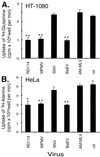The RD114/simian type D retrovirus receptor is a neutral amino acid transporter
- PMID: 10051606
- PMCID: PMC26748
- DOI: 10.1073/pnas.96.5.2129
The RD114/simian type D retrovirus receptor is a neutral amino acid transporter
Abstract
The RD114/simian type D retroviruses, which include the feline endogenous retrovirus RD114, all strains of simian immunosuppressive type D retroviruses, the avian reticuloendotheliosis group including spleen necrosis virus, and baboon endogenous virus, use a common cell-surface receptor for cell entry. We have used a retroviral cDNA library approach, involving transfer and expression of cDNAs from highly infectable HeLa cells to nonpermissive NIH 3T3 mouse cells, to clone and identify this receptor. The cloned cDNA, denoted RDR, is an allele of the previously cloned neutral amino acid transporter ATB0 (SLC1A5). Both RDR and ATB0 serve as retrovirus receptors and both show specific transport of neutral amino acids. We have localized the receptor by radiation hybrid mapping to a region of about 500-kb pairs on the long arm of human chromosome 19 at q13.3. Infection of cells with RD114/type D retroviruses results in impaired amino acid transport, suggesting a mechanism for virus toxicity and immunosuppression. The identification and functional characterization of this retrovirus receptor provide insight into the retrovirus life cycle and pathogenesis and will be an important tool for optimization of gene therapy using vectors derived from RD114/type D retroviruses.
Figures



Similar articles
-
A sodium-dependent neutral-amino-acid transporter mediates infections of feline and baboon endogenous retroviruses and simian type D retroviruses.J Virol. 1999 May;73(5):4470-4. doi: 10.1128/JVI.73.5.4470-4474.1999. J Virol. 1999. PMID: 10196349 Free PMC article.
-
Sodium-dependent neutral amino acid transporter type 1 is an auxiliary receptor for baboon endogenous retrovirus.J Virol. 2000 Sep;74(17):8085-93. doi: 10.1128/jvi.74.17.8085-8093.2000. J Virol. 2000. PMID: 10933718 Free PMC article.
-
N-linked glycosylation and sequence changes in a critical negative control region of the ASCT1 and ASCT2 neutral amino acid transporters determine their retroviral receptor functions.J Virol. 2003 Mar;77(5):2936-45. doi: 10.1128/jvi.77.5.2936-2945.2003. J Virol. 2003. PMID: 12584318 Free PMC article.
-
Retroviruses of the RDR superinfection interference group: ancient origins and broad host distribution of a promiscuous Env gene.Curr Opin Virol. 2017 Aug;25:105-112. doi: 10.1016/j.coviro.2017.07.020. Epub 2017 Aug 19. Curr Opin Virol. 2017. PMID: 28837888 Review.
-
Cell-surface receptors for retroviruses and implications for gene transfer.Proc Natl Acad Sci U S A. 1996 Oct 15;93(21):11407-13. doi: 10.1073/pnas.93.21.11407. Proc Natl Acad Sci U S A. 1996. PMID: 8876148 Free PMC article. Review.
Cited by
-
Receptor usage of Syncytin-1: ASCT2, but not ASCT1, is a functional receptor and effector of cell fusion in the human placenta.Proc Natl Acad Sci U S A. 2024 Oct 29;121(44):e2407519121. doi: 10.1073/pnas.2407519121. Epub 2024 Oct 21. Proc Natl Acad Sci U S A. 2024. PMID: 39432789 Free PMC article.
-
Unique Structure and Distinctive Properties of the Ancient and Ubiquitous Gamma-Type Envelope Glycoprotein.Viruses. 2023 Jan 18;15(2):274. doi: 10.3390/v15020274. Viruses. 2023. PMID: 36851488 Free PMC article. Review.
-
An all-feline retroviral packaging system for transduction of human cells.Hum Gene Ther. 2010 Aug;21(8):1019-27. doi: 10.1089/hum.2010.032. Hum Gene Ther. 2010. PMID: 20222826 Free PMC article.
-
An envelope glycoprotein of the human endogenous retrovirus HERV-W is expressed in the human placenta and fuses cells expressing the type D mammalian retrovirus receptor.J Virol. 2000 Apr;74(7):3321-9. doi: 10.1128/jvi.74.7.3321-3329.2000. J Virol. 2000. PMID: 10708449 Free PMC article.
-
Characterization of retroviral and lentiviral vectors pseudotyped with xenotropic murine leukemia virus-related virus envelope glycoprotein.Hum Gene Ther. 2010 Dec;21(12):1665-73. doi: 10.1089/hum.2010.063. Epub 2010 Sep 17. Hum Gene Ther. 2010. PMID: 20507233 Free PMC article.
References
-
- Weiss R A. In: The Retroviridae. Levy J A, editor. Vol. 2. New York: Plenum; 1993. pp. 1–108.
-
- Wimer E. In: Cellular Receptors for Animal Retroviruses. Wimer E, editor. Plainview, NY: Cold Spring Harbor Lab. Press; 1994. pp. 1–13.
-
- Hunter E. In: Retroviruses. Coffin J M, Hughes S H, Varmus H, editors. Plainview, NY: Cold Spring Harbor Lab. Press; 1997. pp. 71–120.
-
- Schnell M J, Johnson J E, Buonocore L, Rose J K. Cell. 1997;90:849–857. - PubMed
-
- Sommerfelt M A, Weiss R A. Virology. 1990;176:58–69. - PubMed
Publication types
MeSH terms
Substances
Associated data
- Actions
- Actions
Grants and funding
LinkOut - more resources
Full Text Sources
Other Literature Sources
Molecular Biology Databases

